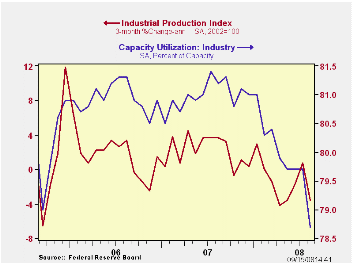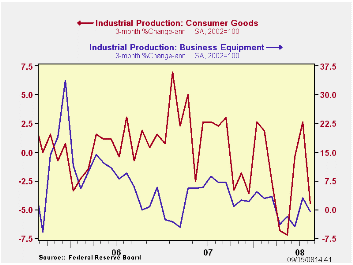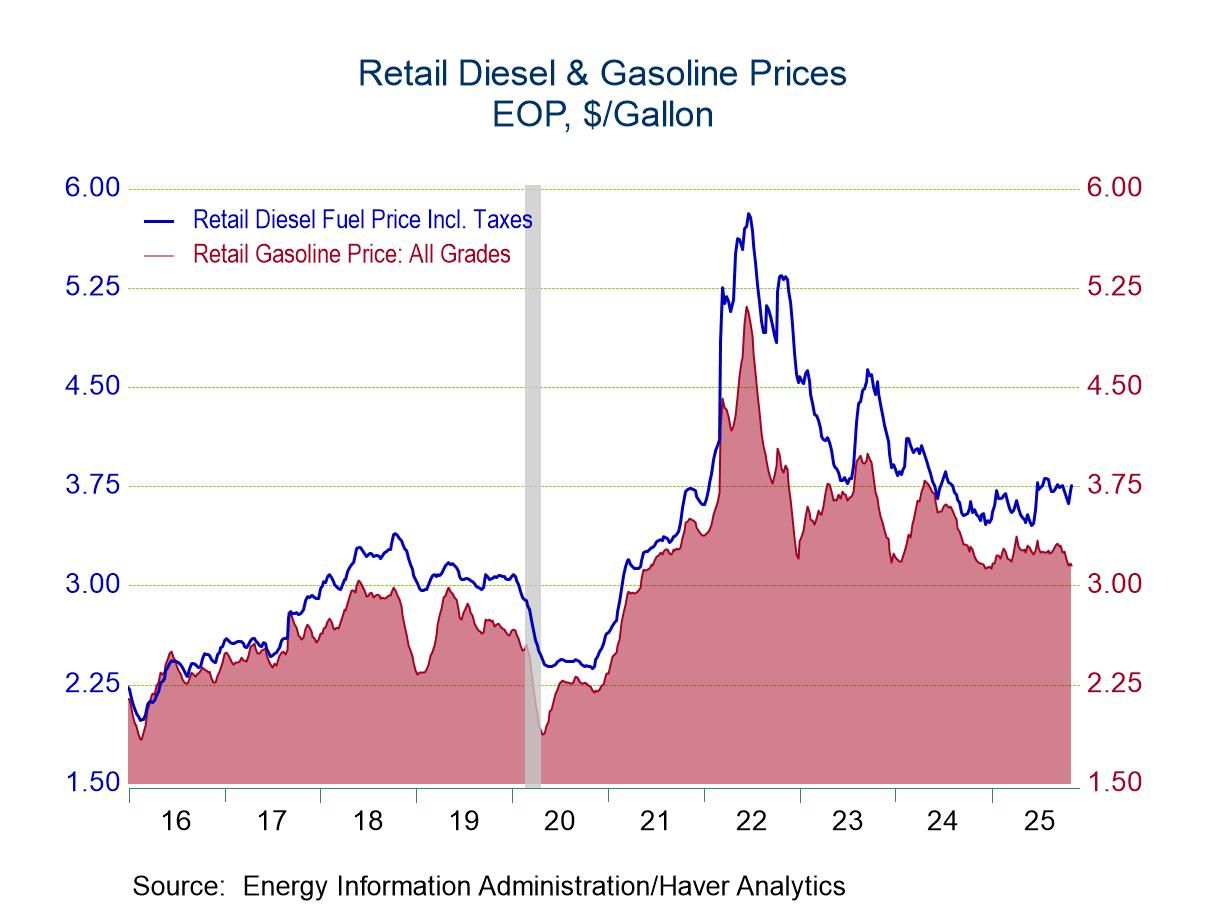 Global| Sep 15 2008
Global| Sep 15 2008U.S. Industrial Production Plummeted; Auto Output Plunged
by:Tom Moeller
|in:Economy in Brief
Summary
August industrial production plummeted 1.2% following a little-revised 0.1% uptick during July. Consensus expectations had been for no change in output last month. The latest monthly decline was the largest since September 2005. The [...]

August industrial production plummeted 1.2% following a little-revised 0.1% uptick during July. Consensus expectations had been for no change in output last month. The latest monthly decline was the largest since September 2005. The y/y change of -1.5% was the worst since 2002, just after the last recession.
Factory output dropped 1.0%, led lower by an 11.9% (-20.7% y/y) decline in the output of motor vehicles & parts. Less autos, output still fell last month but by a moderate 0.3% (-0.6% y/y). That year-to-year change in output less autos of 0.6% indeed was the weakest reading since 2002. It compares to growth of negative 6.0% by the end of the last recession.
Output in the high-tech sector ticked up 0.1% (19.4% y/y) after a 1.3% surge during July. Less high-tech, factory output fell 1.0%, dragged lower by that drop in auto production. Less both autos and high-tech, output fell 0.4% (-1.8% y/y) last month.
Indeed the industry detail continued mixed, but mostly weak. August output of furniture fell 2.9% (-13.1% y/y). Apparel output dropped 0.9% (-3.2% y/y) last month while paper production was off 0.5% (-3.1% y/y). Production of chemicals fell 0.3% (-1.1% y/y) and electrical equipment fell 1.9% (-0.8% y/y). To the upside was output of primary metals which rose by 0.5% ( 0.2% y/y).
In the high-tech area, production of computers & office equipment rose 0.8% (17.3% y/y) while output of communications equipment was unchanged last month but up 15.9% y/y. Semiconductor output ticked down 0.3%. It was up 2.6% year-over-year.
Capacity utilization fell to 78.7% which was its lowest level since 2004. Utilization in the factory sector dropped to 76.6% versus which also was it's lowest since late-2004.
The Federal Reserve Board on Sunday announced several initiatives to provide additional support to financial markets and the full report can be found here.
| INDUSTRIAL PRODUCTION (SA, %) | August | July | Y/Y | 2007 | 2006 | 2005 |
|---|---|---|---|---|---|---|
| Total Output | -1.2 | 0.1 | -1.5 | 1.7 | 2.2 | 3.3 |
| Manufacturing | -1.0 | 0.1 | -1.9 | 1.7 | 2.4 | 4.0 |
| Consumer Goods | -2.0 | 0.2 | -3.0 | 1.7 | 0.3 | 2.8 |
| Business Equipment | -0.6 | 0.2 | 0.7 | 3.3 | 10.4 | 7.3 |
| Construction Supplies | -1.1 | 0.5 | -5.8 | -2.5 | 2.2 | 4.5 |
| Utilities | -3.2 | -1.6 | -4.2 | 3.3 | -0.6 | 2.1 |
| Capacity Utilization | 78.7 | 79.7 | 81.2 | 81.0 | 80.9 | 80.2 |
Tom Moeller
AuthorMore in Author Profile »Prior to joining Haver Analytics in 2000, Mr. Moeller worked as the Economist at Chancellor Capital Management from 1985 to 1999. There, he developed comprehensive economic forecasts and interpreted economic data for equity and fixed income portfolio managers. Also at Chancellor, Mr. Moeller worked as an equity analyst and was responsible for researching and rating companies in the economically sensitive automobile and housing industries for investment in Chancellor’s equity portfolio. Prior to joining Chancellor, Mr. Moeller was an Economist at Citibank from 1979 to 1984. He also analyzed pricing behavior in the metals industry for the Council on Wage and Price Stability in Washington, D.C. In 1999, Mr. Moeller received the award for most accurate forecast from the Forecasters' Club of New York. From 1990 to 1992 he was President of the New York Association for Business Economists. Mr. Moeller earned an M.B.A. in Finance from Fordham University, where he graduated in 1987. He holds a Bachelor of Arts in Economics from George Washington University.






